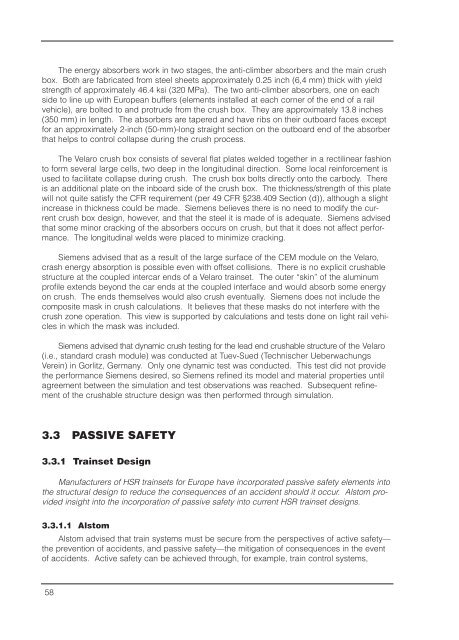Pioneering the Application of High Speed Rail Express Trainsets in ...
Pioneering the Application of High Speed Rail Express Trainsets in ...
Pioneering the Application of High Speed Rail Express Trainsets in ...
You also want an ePaper? Increase the reach of your titles
YUMPU automatically turns print PDFs into web optimized ePapers that Google loves.
The energy absorbers work <strong>in</strong> two stages, <strong>the</strong> anti-climber absorbers and <strong>the</strong> ma<strong>in</strong> crush<br />
box. Both are fabricated from steel sheets approximately 0.25 <strong>in</strong>ch (6,4 mm) thick with yield<br />
strength <strong>of</strong> approximately 46.4 ksi (320 MPa). The two anti-climber absorbers, one on each<br />
side to l<strong>in</strong>e up with European buffers (elements <strong>in</strong>stalled at each corner <strong>of</strong> <strong>the</strong> end <strong>of</strong> a rail<br />
vehicle), are bolted to and protrude from <strong>the</strong> crush box. They are approximately 13.8 <strong>in</strong>ches<br />
(350 mm) <strong>in</strong> length. The absorbers are tapered and have ribs on <strong>the</strong>ir outboard faces except<br />
for an approximately 2-<strong>in</strong>ch (50-mm)-long straight section on <strong>the</strong> outboard end <strong>of</strong> <strong>the</strong> absorber<br />
that helps to control collapse dur<strong>in</strong>g <strong>the</strong> crush process.<br />
The Velaro crush box consists <strong>of</strong> several flat plates welded toge<strong>the</strong>r <strong>in</strong> a rectil<strong>in</strong>ear fashion<br />
to form several large cells, two deep <strong>in</strong> <strong>the</strong> longitud<strong>in</strong>al direction. Some local re<strong>in</strong>forcement is<br />
used to facilitate collapse dur<strong>in</strong>g crush. The crush box bolts directly onto <strong>the</strong> carbody. There<br />
is an additional plate on <strong>the</strong> <strong>in</strong>board side <strong>of</strong> <strong>the</strong> crush box. The thickness/strength <strong>of</strong> this plate<br />
will not quite satisfy <strong>the</strong> CFR requirement (per 49 CFR §238.409 Section (d)), although a slight<br />
<strong>in</strong>crease <strong>in</strong> thickness could be made. Siemens believes <strong>the</strong>re is no need to modify <strong>the</strong> current<br />
crush box design, however, and that <strong>the</strong> steel it is made <strong>of</strong> is adequate. Siemens advised<br />
that some m<strong>in</strong>or crack<strong>in</strong>g <strong>of</strong> <strong>the</strong> absorbers occurs on crush, but that it does not affect performance.<br />
The longitud<strong>in</strong>al welds were placed to m<strong>in</strong>imize crack<strong>in</strong>g.<br />
Siemens advised that as a result <strong>of</strong> <strong>the</strong> large surface <strong>of</strong> <strong>the</strong> CEM module on <strong>the</strong> Velaro,<br />
crash energy absorption is possible even with <strong>of</strong>fset collisions. There is no explicit crushable<br />
structure at <strong>the</strong> coupled <strong>in</strong>tercar ends <strong>of</strong> a Velaro tra<strong>in</strong>set. The outer “sk<strong>in</strong>” <strong>of</strong> <strong>the</strong> alum<strong>in</strong>um<br />
pr<strong>of</strong>ile extends beyond <strong>the</strong> car ends at <strong>the</strong> coupled <strong>in</strong>terface and would absorb some energy<br />
on crush. The ends <strong>the</strong>mselves would also crush eventually. Siemens does not <strong>in</strong>clude <strong>the</strong><br />
composite mask <strong>in</strong> crush calculations. It believes that <strong>the</strong>se masks do not <strong>in</strong>terfere with <strong>the</strong><br />
crush zone operation. This view is supported by calculations and tests done on light rail vehicles<br />
<strong>in</strong> which <strong>the</strong> mask was <strong>in</strong>cluded.<br />
Siemens advised that dynamic crush test<strong>in</strong>g for <strong>the</strong> lead end crushable structure <strong>of</strong> <strong>the</strong> Velaro<br />
(i.e., standard crash module) was conducted at Tuev-Sued (Technischer Ueberwachungs<br />
Vere<strong>in</strong>) <strong>in</strong> Gorlitz, Germany. Only one dynamic test was conducted. This test did not provide<br />
<strong>the</strong> performance Siemens desired, so Siemens ref<strong>in</strong>ed its model and material properties until<br />
agreement between <strong>the</strong> simulation and test observations was reached. Subsequent ref<strong>in</strong>ement<br />
<strong>of</strong> <strong>the</strong> crushable structure design was <strong>the</strong>n performed through simulation.<br />
3.3 PASSIVE SAFETY<br />
3.3.1 Tra<strong>in</strong>set Design<br />
Manufacturers <strong>of</strong> HSR tra<strong>in</strong>sets for Europe have <strong>in</strong>corporated passive safety elements <strong>in</strong>to<br />
<strong>the</strong> structural design to reduce <strong>the</strong> consequences <strong>of</strong> an accident should it occur. Alstom provided<br />
<strong>in</strong>sight <strong>in</strong>to <strong>the</strong> <strong>in</strong>corporation <strong>of</strong> passive safety <strong>in</strong>to current HSR tra<strong>in</strong>set designs.<br />
3.3.1.1 Alstom<br />
Alstom advised that tra<strong>in</strong> systems must be secure from <strong>the</strong> perspectives <strong>of</strong> active safety—<br />
<strong>the</strong> prevention <strong>of</strong> accidents, and passive safety—<strong>the</strong> mitigation <strong>of</strong> consequences <strong>in</strong> <strong>the</strong> event<br />
<strong>of</strong> accidents. Active safety can be achieved through, for example, tra<strong>in</strong> control systems,<br />
58
















